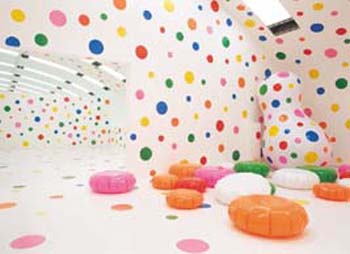Yayoi Kusama
dal 7/2/2002 al 28/4/2002
Segnalato da
Yayoi Kusama
Xavier Douroux
Sabine Folie
Franck Gautherot
Michael Glasmeier
Sabine Folie
Felix Guattari
Laura Hoptman
Seung-duk Kim
Gerald Matt
Pecoil
7/2/2002
Yayoi Kusama
Kunsthalle Wien, Wien
Kusama's universe is made up from dots and infinite meshwork structures, which characteristically proliferate from watercolors, drawings, and paintings onto objects and entire rooms. Neighboring on Pop Art, Minimalism, and Abstract Expressionism, Kusama has developed an oeuvre which is strongly informed by political and feminist issues as well as by mystical ideas and which she prefers to refer to as 'obsessional art'.

Hall 1
With her obsessive objects, installations, and environments, Yayoi Kusama, one
of the most versatile and internationally most successful contemporary artists from
Japan, -has won much attention since the 1960s. Kusama's universe is made up
from dots and infinite meshwork structures, which characteristically proliferate
from watercolors, drawings, and paintings onto objects and entire rooms.
Neighboring on Pop Art, Minimalism, and Abstract Expressionism, Kusama has
developed an oeuvre which is strongly informed by political and feminist issues
as well as by mystical ideas and which she prefers to refer to as 'obsessional art'.
Featuring a series of new room installations, the Kunsthalle Wien presents, for the
first time in Middle Europe, a major personal exhibition of the artist who has
become known as the 'polka-dot princess'.
After her studies of classical Japanese Nihonga painting, Yayoi Kusama (b. 1929
in Japan) broke away from the narrowness of her parental home and the
Japanese society in 1958 and went to New York City to find the freedom she
needed to pursue her artistic work
Starting from painting, Kusama's work expresses ideas such as the obliterating
of the distinction between the artwork, the artist, and life, develops environment
concepts from the principle of the serial all-over, and formulates approaches that
were later taken up again from feminist art positions.
Even in her earliest paintings and drawings, infinite net structures, spots and dots
create an expanding and pulsating visual universe the origins of which Kusama
herself traces back to childhood visions and hallucinations. Her passionate
expressiveness soon went beyond painting, and the characteristic Polka dots and
Infinity Nets of her imaginative world started to overgrow - as phallic
protuberances, noodles, or simple points - objects, furniture, and finally, entire
rooms. This lead to the first environments in the mid-60s, in which Kusama, using
repetitive patterns, serial structures, countless dots, and a vast variety of
materials, worked on creating an illusion of the obliteration of objects, spaces,
and people.
The idea of 'self-obliteration' is also crucial to the nude performances, announced
as body and love performances, which Kusama made, beginning in the mid-60s,
mainly in public places in New York City. These performances responded to
virulent political issues of the era such as the Nixon affair or the Vietnam War, or
related to cultural political developments such as the increasing
commercialization of the art market. Thus Kusama expressed criticism of
established art-world conventions at the 1966 Venice Biennale when she, in a
spontaneous action, offered the silver balls from her outdoor Narcissus Garden
installation to visitors for sale, for two dollars each.
In the 1960s, Kusama's work was read in America in the context of Pop Art,
Minimal Art , or Abstract Expressionism. Her 'Infinity Nets', paintings without
composition consisting of endless net structures, at first sight seem to combine
the painterly approach of Abstract Expressionism with the reduced aesthetics of
Minimal Art. Her collages and furniture objects, in which the principle of
serialization is applied on the basis of everyday objects, were seen as related to
pieces by pop artists like Warhol, Rosenquist, or Oldenburg. However, Kusama
does not comment mass culture; unlike the industrial materials and makings of
minimal art, her objects are deliberately given organic shaves and have a
handmade quality. And while Zero and other groups of the 'New Tendency' in
Europe, in whose exhibitions Kusama participated in Italy, Germany, and the
Netherlands in the 60s, made the artist-subject step to the background, placing
the focus on explorations of material, color, light and motion instead, Kusama's
personality, with all her inherent contradictions, is inscribed in each of her pieces,
and self-enactment is an integral part of her oeuvre.
In 1974, Kusama returned to Japan and started to write autobiographical
narrative texts and poems about her New York time and experience, which are
read by a growing community of Japanese fans and have received literary
awards. It took until the late 1980s that her significance as a visual artist for both
younger generations of artists and art history was rediscovered and appreciated
in numerous exhibitions. In 1993, she was the first artist ever to be given a single
exhibition at the Venice Biennale Japanese pavilion.
The Vienna exhibition features new room installations which, in the playful and
obsessive manner they incorporate repetitive structures and reflections, carry the
disintegration of object and surrounding space, as intended by Kusama, to a new
height. Against the background of an encompassing exhibition design by the
Pauhof architectural team, which takes up the ideas of reflection and repetition,
Kusama's infinite universes become a palpable experience in the environments.
Aside from videos, slide shows, and fashion designs, two installations from the
60s, Narcissus Garden and Infinity Mirror Room - Love forever, will also be
shown in the exhibition.
An exhibition of Kunsthalle Wien in collaboration with Le Consortium, Dijon and
Studio Kusama, Tokyo.
Vienna Curator: Sabine Folie
Exhibition Design: Pauhof Architects (Vienna, Berlin)
Exhibition-catalogue (in German): Kunsthalle Wien (editor), Yayoi Kusama With contributions of Xavier Douroux, Sabine Folie, Franck Gautherot, Michael Glasmeier, Félix Guattari, Laura Hoptman, Seung-duk Kim, Gerald Matt and Vincent Pécoil
Image: Yayoi Kusama, Dots Obsession, New Century, 1998, Installationview, 2002, Foto: Christian Wachter
Kunsthalle Wien, Museumsplatz 1, A- 1070 Vienna
daily 10 a.m. to 7 p.m., Thursdays 10 a.m. to 10p.m



